Research on the Indoor Thermal Environment of Attached Sunspace Passive Solar Heating System Based on Zero-State Response Control Strategy
Abstract
:Featured Application
Abstract
1. Introduction
2. Methodology
2.1. Layout of the Farmhouse
2.2. Experimental Setup
- (1)
- Outdoor side parameters: the portable weather station were used to measure outdoor temperature, humidity and solar radiation strength. The measuring points were located on the room’s roof.
- (2)
- Attached sunspace parameters: the heat flow meters were used to measure the heat flow of the heat storage partition wall, and the temperature and humidity recorders were used to measure the temperature and humidity of the air layer. Figure 4a shows the configuration of the measuring points.
- (3)
- Indoor side parameters: the temperature and humidity recorder was used to measure the indoor temperature and humidity. Figure 4b shows the configuration of the measuring points.
2.3. System Modeling
2.3.1. TRNSYS Model
2.3.2. Model Verification
3. Results
3.1. Zero-State Response Control Strategies
- Zero-state: if the temperature of the attached sunspace is lower than the room, the active interior window is at the closed state and prevents air flow through the windows.
- Response-state: if the temperature of the attached sunspace is higher than the room, the interior active window is in the opened state and delivers air flow through the windows.
3.1.1. Opening Time at Morning
3.1.2. Closing Time at Dusk
3.2. Daytime Thermal Environments
3.2.1. Choice of Sample Day
3.2.2. Temperature of Room under Zero-State Response Control Strategy
3.2.3. Attached Sunspace’s Thermal Environment
3.2.4. Indoor Thermal Environment
3.3. Heating Effects throughout the Winter
3.3.1. Heating Assurance Rate
3.3.2. Energy-Saving Efficiency
3.3.3. Carbon Emission Reduction
4. Discussion
5. Conclusions
- (1)
- The temperature difference of an attached sunspace with a room provides power for passive heating. The zero-state response control strategy of the interior active window should be related to the temperature difference. The temperature difference is about 10 °C, which can provide better heating effect.
- (2)
- During the day, an attached sunspace’s passive heating can offer a more suitable thermal environment for the farmhouse. When solar radiation is intensive, opening the interior active window can raise the internal temperature to an average of 25.45 °C higher than the outside, with a 23% discernible indoor average temperature differential indoor.
- (3)
- Using an ASPSHS with a zero-state response control strategy, farmhouses in cold places can maintain an internal temperature of 14 °C for more than 37.99% of the time in winter and meet 73.33% of the daytime heating time.
- (4)
- The farmhouse with attached sunspace under zero-state response control strategy can greatly reduce operating energy consumption and carbon emissions. Compared with a farmhouse without an attached sunspace, the energy for heating can be saved by 39.86%; compared to a farmhouse with an attached sunspace but not under the zero-state response control strategy, the energy for heating can be saved by 24.06%, and carbon emission reduction can be increased by 51.73%.
Author Contributions
Funding
Institutional Review Board Statement
Informed Consent Statement
Data Availability Statement
Conflicts of Interest
References
- Chen, X.; Shuai, C.; Wu, Y.; Zhang, Y. Analysis on the carbon emission peaks of China’s industrial, building, transport, and agricultural sectors. Sci. Total Environ. 2020, 709, 135768. [Google Scholar] [CrossRef] [PubMed]
- Jiang, Y.; Hu, S. Paths to carbon neutrality in China’s building sector. Heat. Vent. Air Cond. 2021, 51, 1–13. [Google Scholar]
- Albayyaa, H.; Hagare, D.; Saha, S. Energy conservation in residential buildings by incorporating Passive Solar and Energy Efficiency Design Strategies and higher thermal mass. Energy Build. 2019, 182, 205–213. [Google Scholar] [CrossRef]
- Yang, J.; Liu, Y.; Chen, Y.; Li, Y.; Zhou, Y. Research of climate regions division for applicable passive solar heating technology selection. Acta Energ. Sol. Sin. 2021, 42, 234–242. [Google Scholar]
- Wang, D.; Liu, Y.; Jiang, J.; Liu, J. The Optimized Matching of Passive Solar Energy supply and Classroom Thermal Demand of Rural Primary and Secondary School in Northwest China. Procedia Eng. 2015, 121, 1089–1095. [Google Scholar] [CrossRef] [Green Version]
- Finocchiaro, L.; Georges, L.; Hestnes, A.G. 6 Passive solar space heating. In Advances in Solar Heating and Cooling; Wang, R.Z., Ge, T.S., Eds.; Woodhead Publishing: Cambridge, MA, USA, 2016; pp. 95–116. [Google Scholar]
- Wang, D.; Hu, L.; Du, H.; Liu, Y.; Huang, J.; Xu, Y.; Liu, J. Classification, experimental assessment, modeling methods and evaluation metrics of Trombe walls. Renew. Sustain. Energy Rev. 2020, 124, 109772. [Google Scholar] [CrossRef]
- Si, P.; Lv, Y.; Rong, X.; Shi, L.; Yan, J.; Wang, X. An innovative building envelope with variable thermal performance for passive heating systems. Appl. Energy 2020, 269, 115175. [Google Scholar] [CrossRef]
- Gong, Q.; Kou, F.; Sun, X.; Zou, Y.; Mo, J.; Wang, X. Towards zero energy buildings: A novel passive solar house integrated with flat gravity-assisted heat pipes. Appl. Energy 2022, 306, 117981. [Google Scholar] [CrossRef]
- Zhang, L.; Ju, X.; Zeng, Y. Interpretation of “Technical Specifications for Passive Solar Buildings”. Constr. Sci. Technol. 2012, pp. 50–54, 57. Available online: http://www.doczj.com/doc/31beb373667d27284b73f242336c1eb91a3733de.html (accessed on 19 November 2021).
- Huo, H.; Xu, W.; Li, A. Comparison and analysis of envelope structure retrofitting schemes for rural residential building in northern china based on entropy method. Build. Sci. 2019, 35, 57–64. [Google Scholar]
- Liu, Z.; Wu, D.; He, B.-J.; Wang, Q.; Yu, H.; Ma, W.; Jin, G. Evaluating potentials of passive solar heating renovation for the energy poverty alleviation of plateau areas in developing countries: A case study in rural Qinghai-Tibet Plateau, China. Sol. Energy 2019, 187, 95–107. [Google Scholar] [CrossRef]
- Wang, W.; Yuan, M.; Li, Y.-Z.; Li, C. Numerical investigation on the impact of an on-top sunspace passive heating approach for typical rural buildings in northern China. Sol. Energy 2019, 186, 300–310. [Google Scholar] [CrossRef]
- Ma, L.; Zhang, X.; Li, D.; Arıcı, M.; Yıldız, Ç.; Li, Q.; Zhang, S.; Jiang, W. Influence of sunspace on energy consumption of rural residential buildings. Sol. Energy 2020, 211, 336–344. [Google Scholar] [CrossRef]
- Lu, S.; Tong, H.; Pang, B. Study on the coupling heating system of floor radiation and sunspace based on energy storage technology. Energy Build. 2018, 159, 441–453. [Google Scholar] [CrossRef]
- Li, Q.; Wang, Y.; Ma, L.; Arıcı, M.; Li, D.; Yıldız, Ç. Effect of sunspace and PCM louver combination on the energy saving of rural residences: Case study in a severe cold region of China. Sustain. Energy Technol. Assess. 2021, 45, 101126. [Google Scholar] [CrossRef]
- Zhou, Y.; Wang, D.; Liu, Y.; Liu, J. Diffuse solar radiation models for different climate zones in China: Model evaluation and general model development. Energy Convers. Manag. 2019, 185, 518–536. [Google Scholar] [CrossRef]
- Liu, Y.; Liu, T.; Ye, S.; Liu, Y. Cost-benefit analysis for Energy Efficiency Retrofit of existing buildings: A case study in China. J. Clean. Prod. 2018, 177, 493–506. [Google Scholar] [CrossRef]
- Jing, Z.; Jiayu, L. Study on heat transfer delay of exposed capillary ceiling radiant panels (E-CCRP) system based on CFD method. Build. Environ. 2020, 180, 106982. [Google Scholar] [CrossRef]
- Baglivo, C.; Mazzeo, D.; Panico, S.; Bonuso, S.; Matera, N.; Congedo, P.M.; Oliveti, G. Data from a dynamic simulation in a free-floating and continuous regime of a solar greenhouse modelled in TRNSYS 17 considering simultaneously different thermal phenomena. Data Brief 2020, 33, 106339. [Google Scholar] [CrossRef]
- Solar Energy Laboratory. TRNSYS Version User Manual and Documentation; University of Wisconsin: Madison, WI, USA, 2014; pp. 25–60. [Google Scholar]
- AG. 14-2014.; Measurement of Energy and Demand Savings. American Society of Heating, Refrigerating and Air-Conditioning Engineers Inc.: Atlanta, GA, USA, 2014.
- Lu, S.; Zhao, Y.; Fang, K.; Li, Y.; Sun, P. Establishment and experimental verification of TRNSYS model for PCM floor coupled with solar water heating system. Energy Build. 2017, 140, 245–260. [Google Scholar] [CrossRef]
- Recknagel, H.; Sprenger, E.; Schramek, E. Taschenbuch für Heizung und Klimatechnik, 75th ed.; Oldenburg Industrieverlag: München, Germany, 2011. [Google Scholar]
- Liu, Z.; Wu, D.; Yu, H.; Ma, W.; Jin, G. Field Measurement and Numerical Simulation of Combined Solar Heating Operation Modes for Domestic Buildings Based on the Qinghai–Tibetan Plateau Case. Energy Build. 2018, 167, 312–321. [Google Scholar] [CrossRef]
- GB/T 50824-2013; Energy-Saving Design Standard for Rural Residential Buildings. CN-GB: Beijing, China, 2013.
- Chen, M.; Shi, Y.; Liu, X. Heating study of passive solar house with sunspace. Acta Energ. Sol. Sin. 2012, 33, 944–947. [Google Scholar]
- Zhang, X.; Xu, J.; Zhang, X.; Li, Y. Life cycle carbon emission reduction potential of a new steel-bamboo composite frame structure for residential houses. J. Build. Eng. 2021, 39, 102295. [Google Scholar] [CrossRef]
- Lu, S.; Zhai, X.; Gao, J.; Wang, R. Performance Optimization and Experimental Analysis of a Novel Low-Temperature Latent Heat Thermal Energy Storage Device. Energy 2021, 12, 2496. [Google Scholar] [CrossRef]
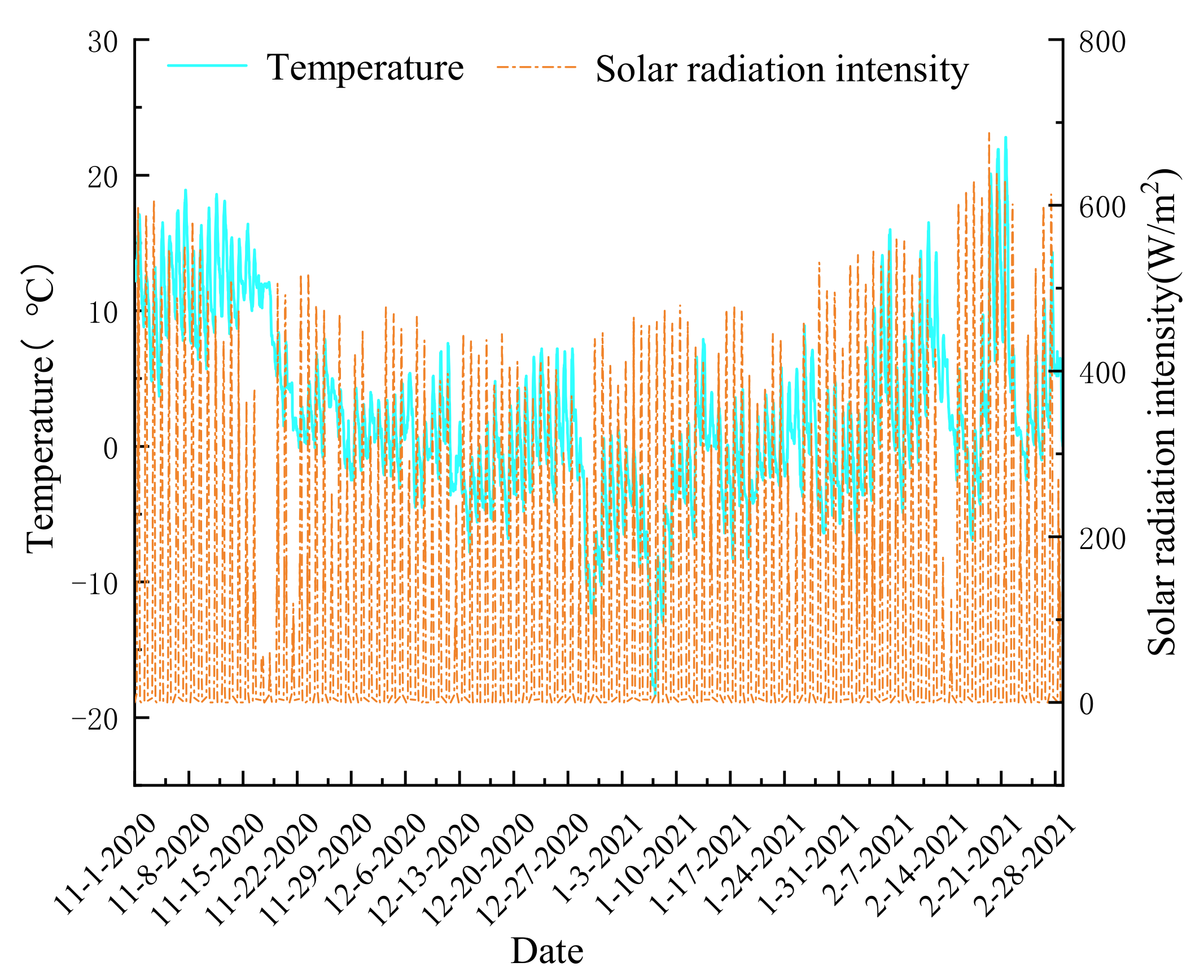
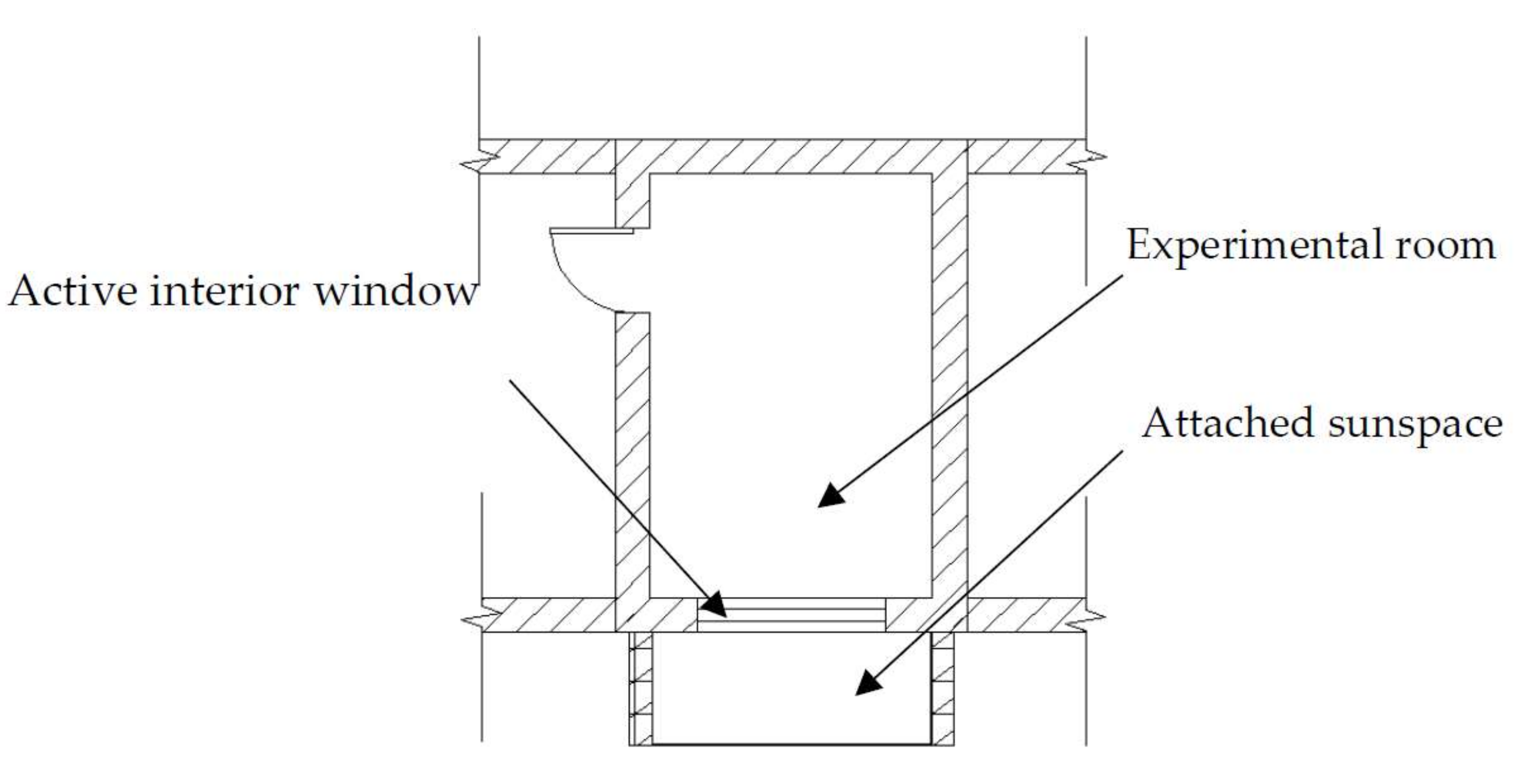

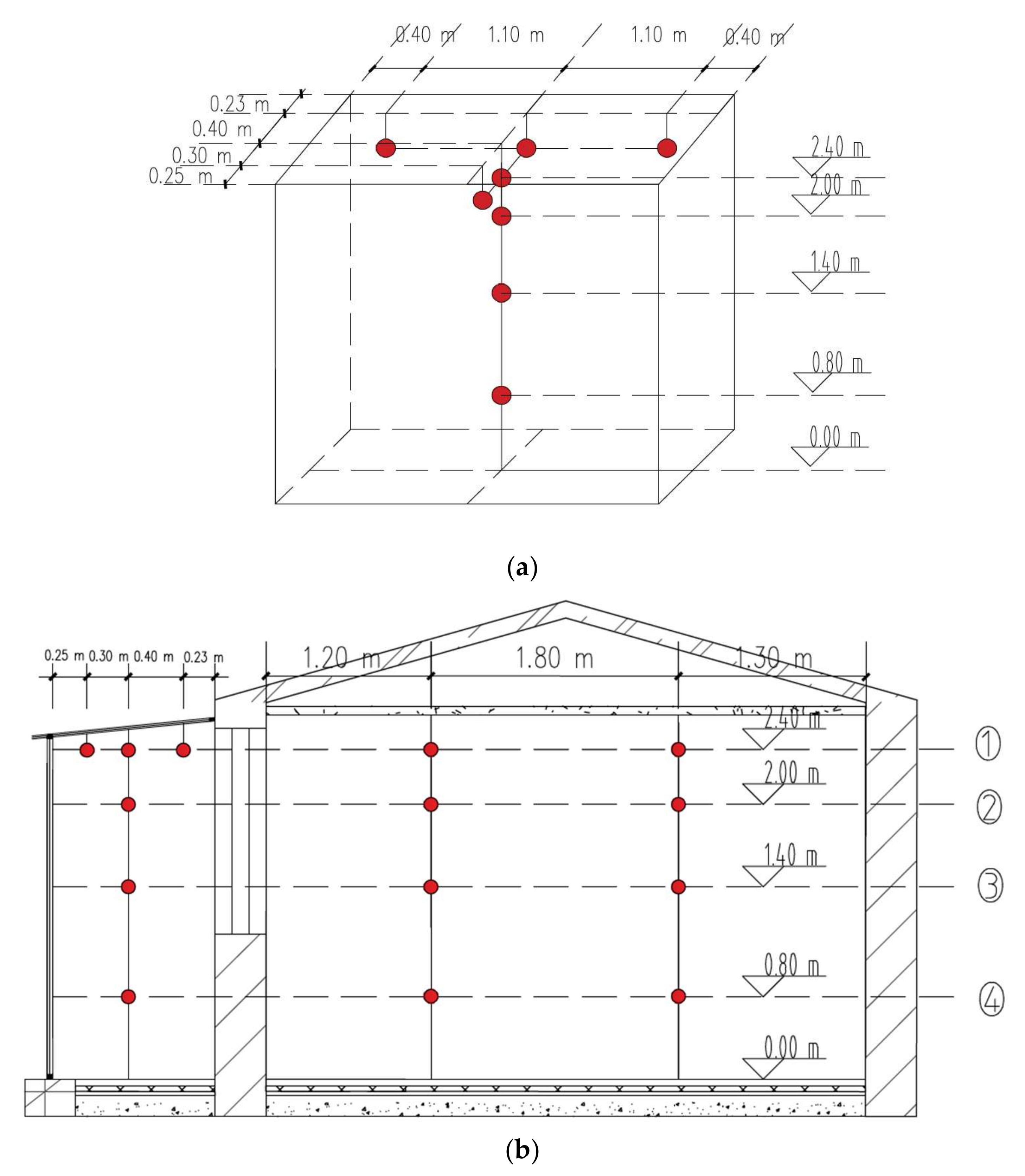
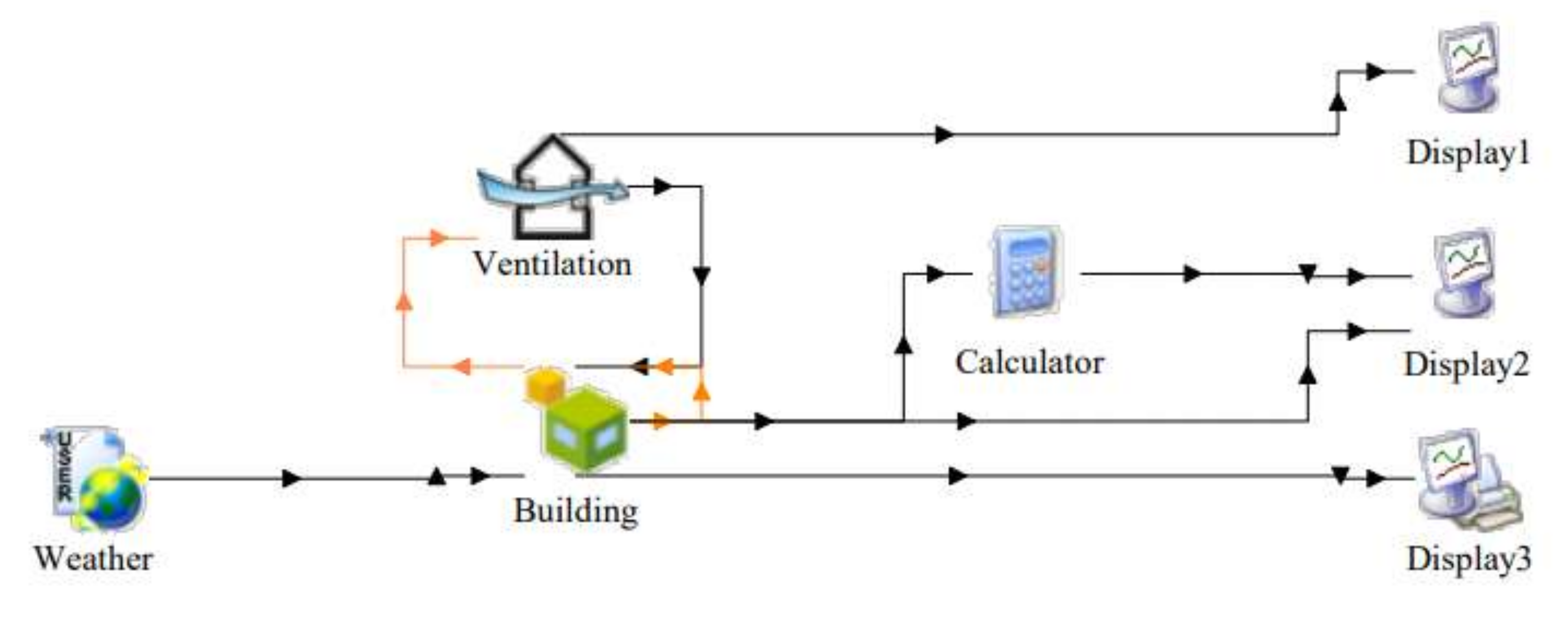
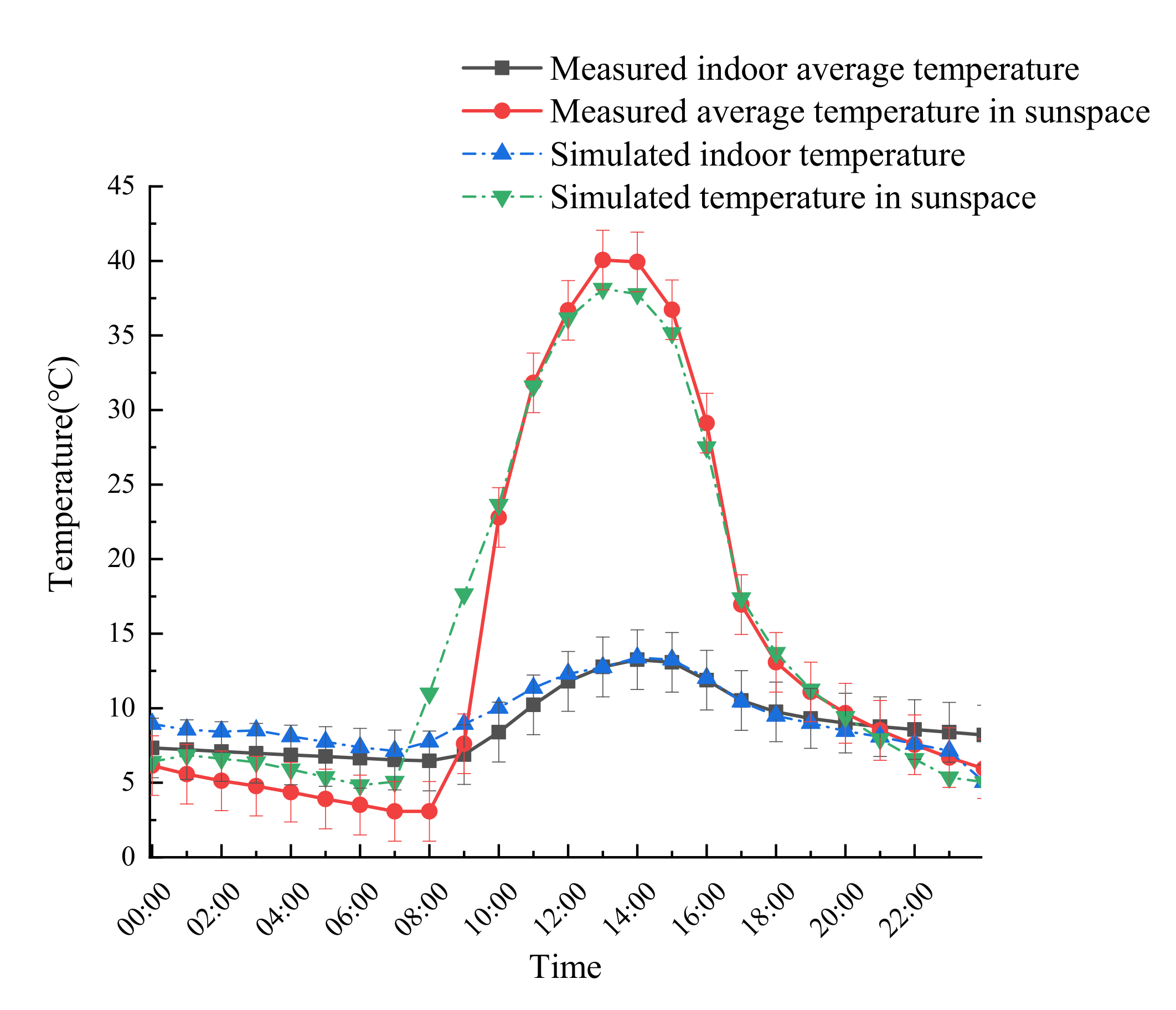
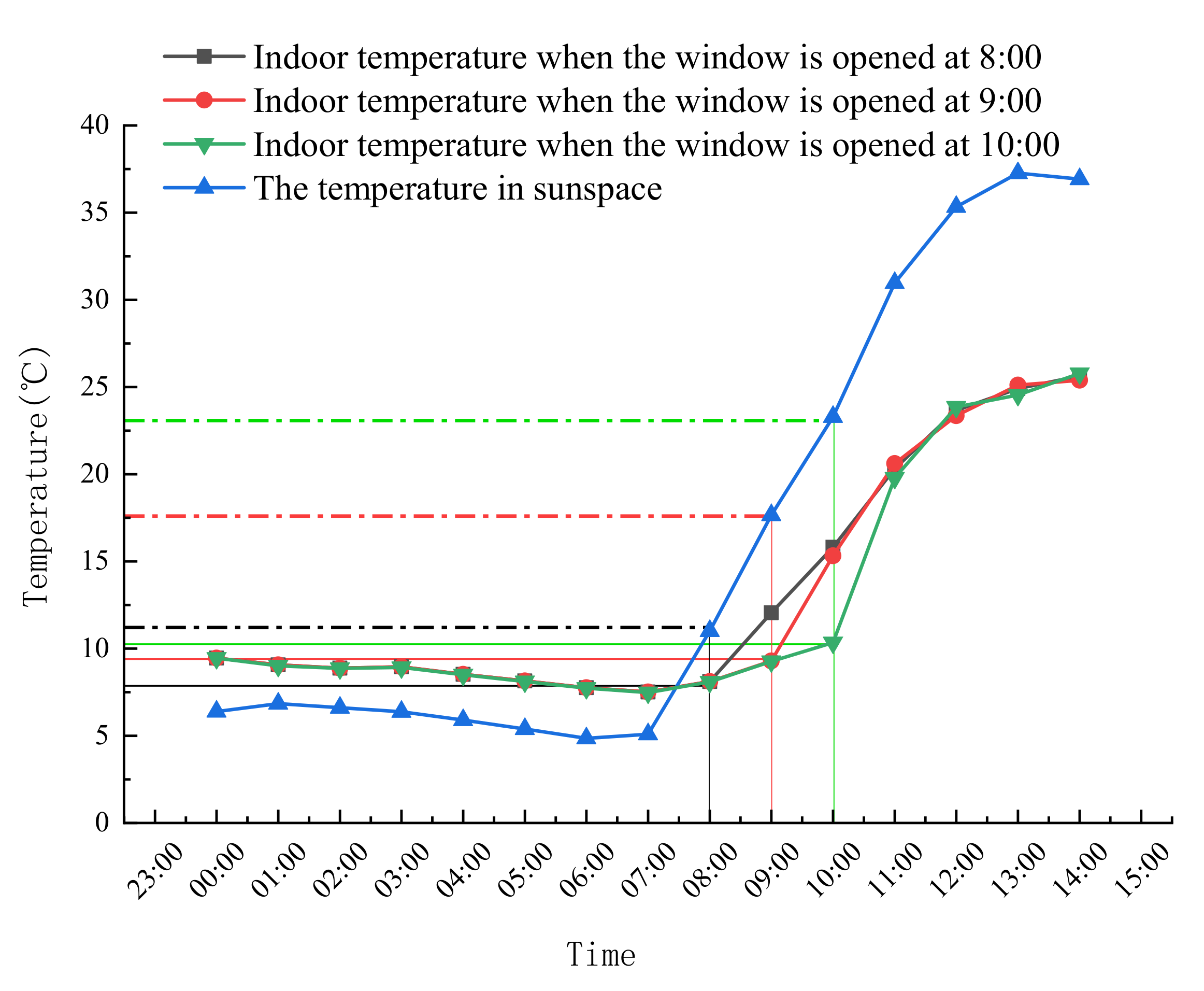
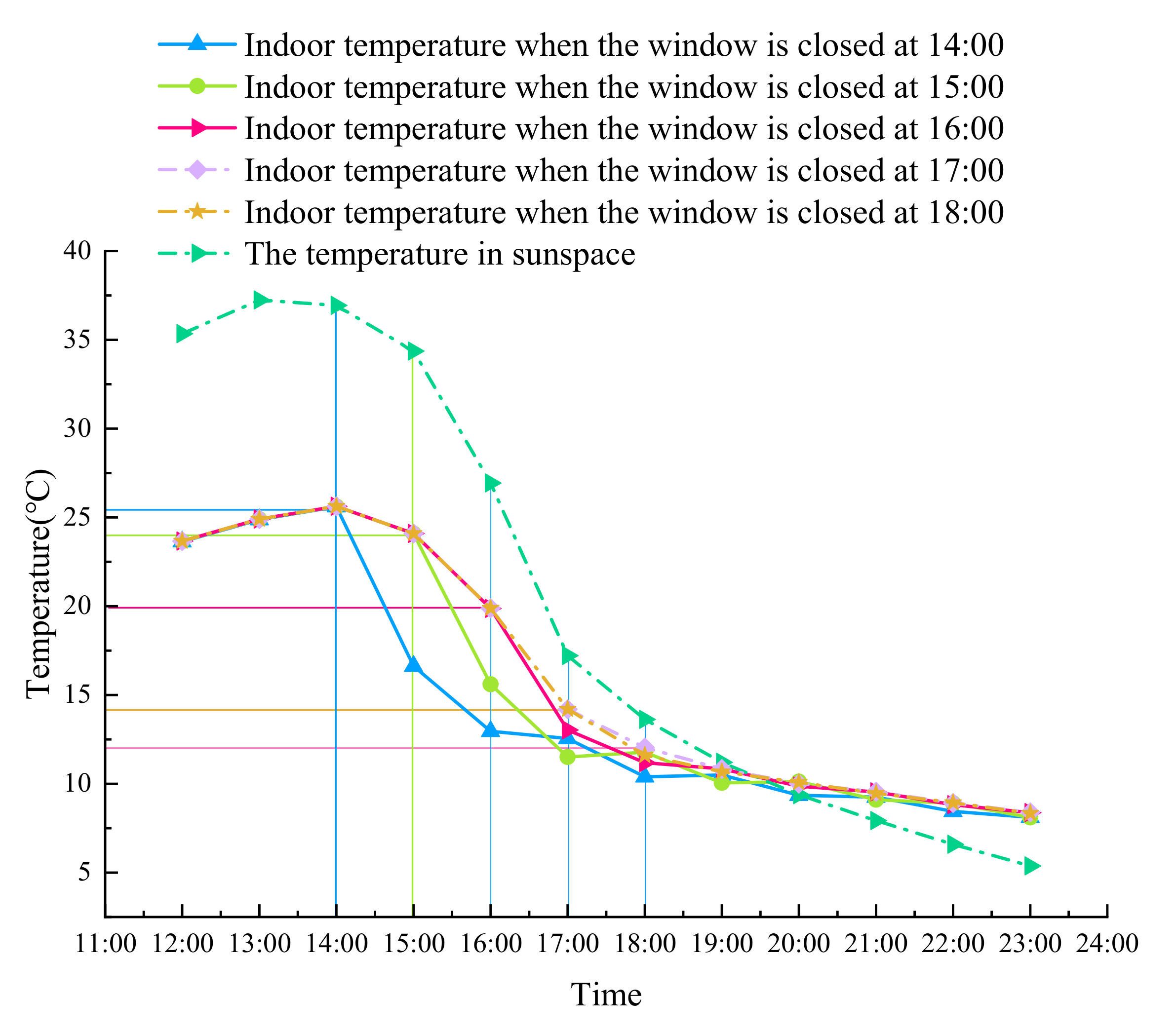
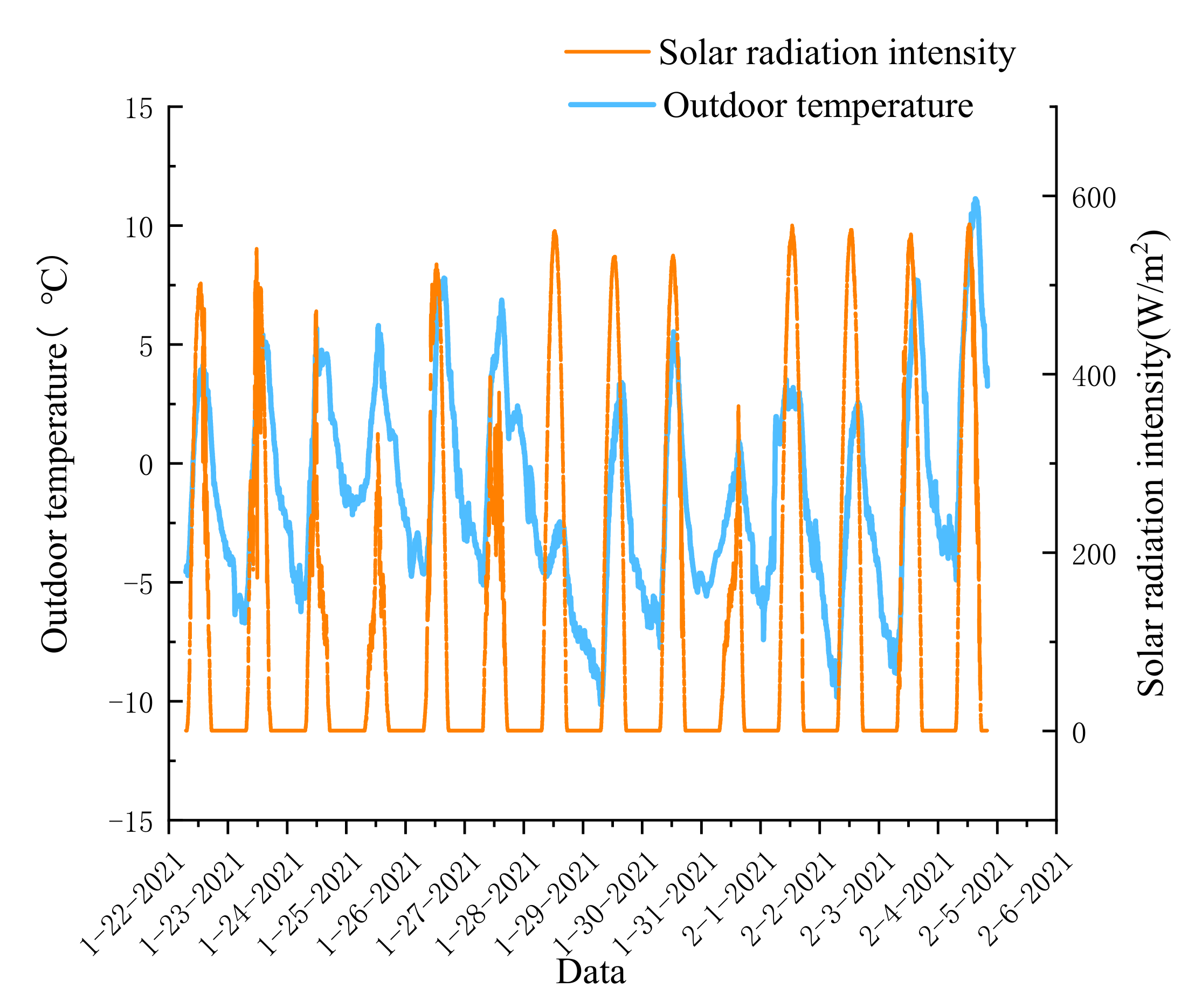
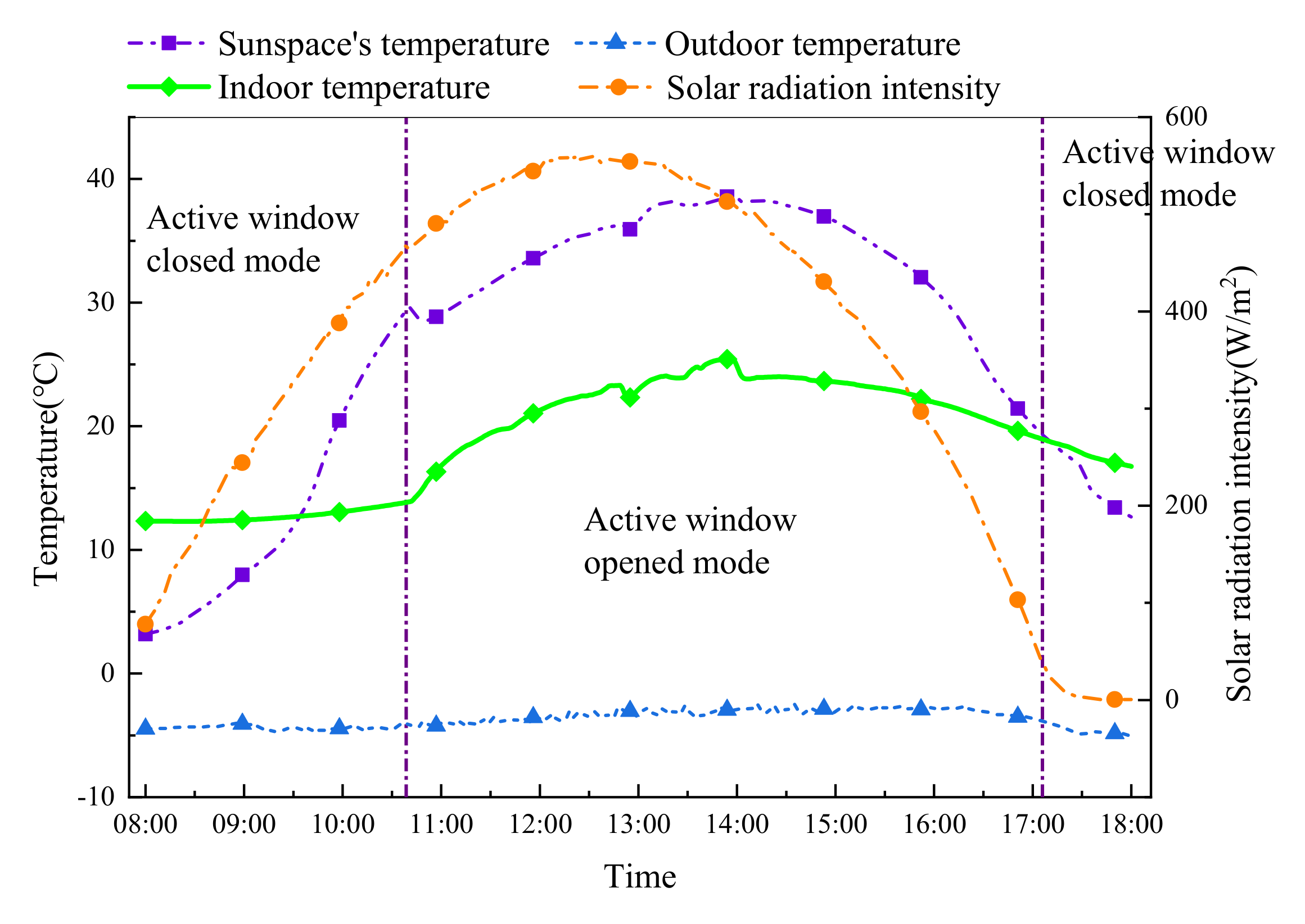

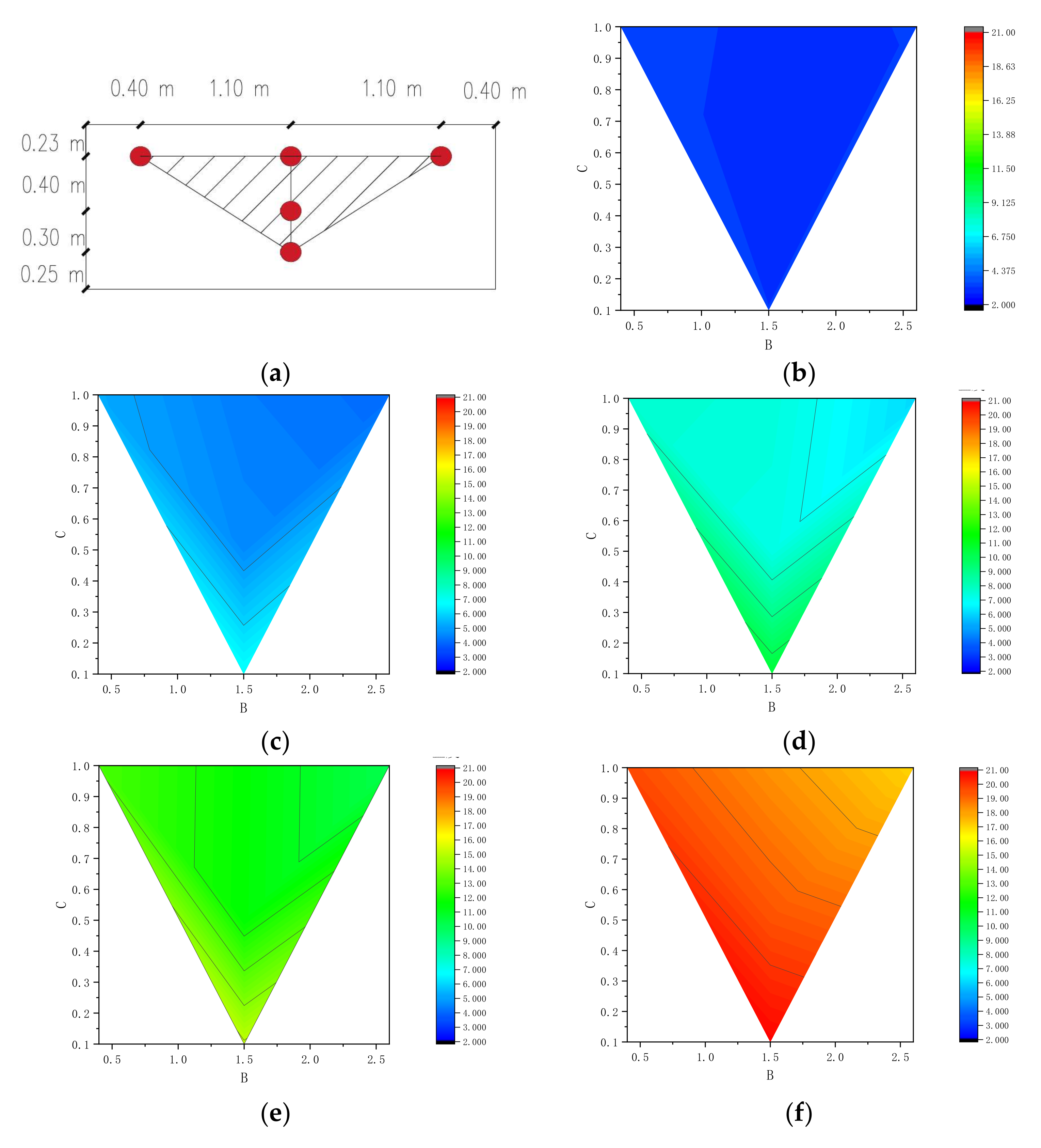
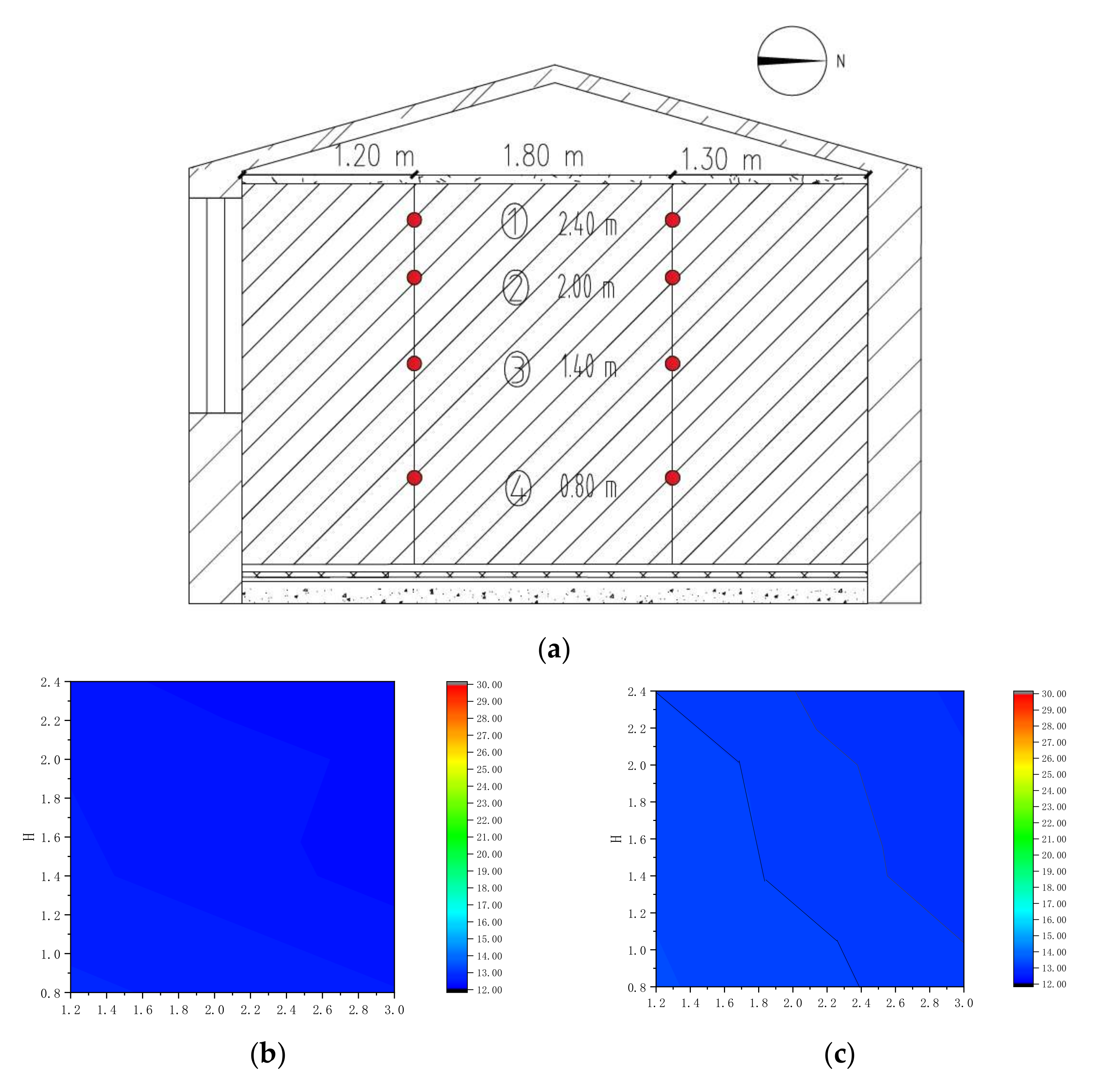

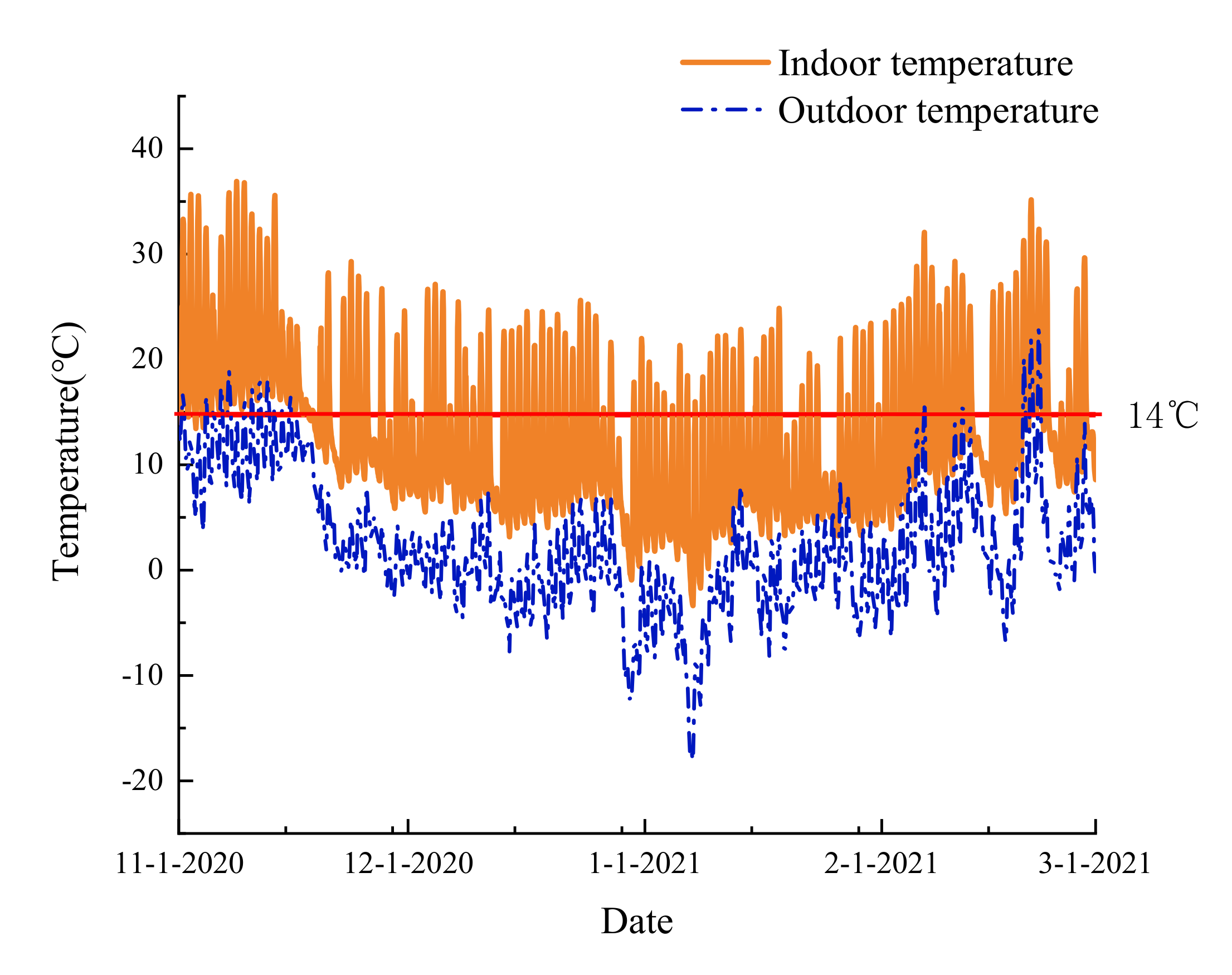
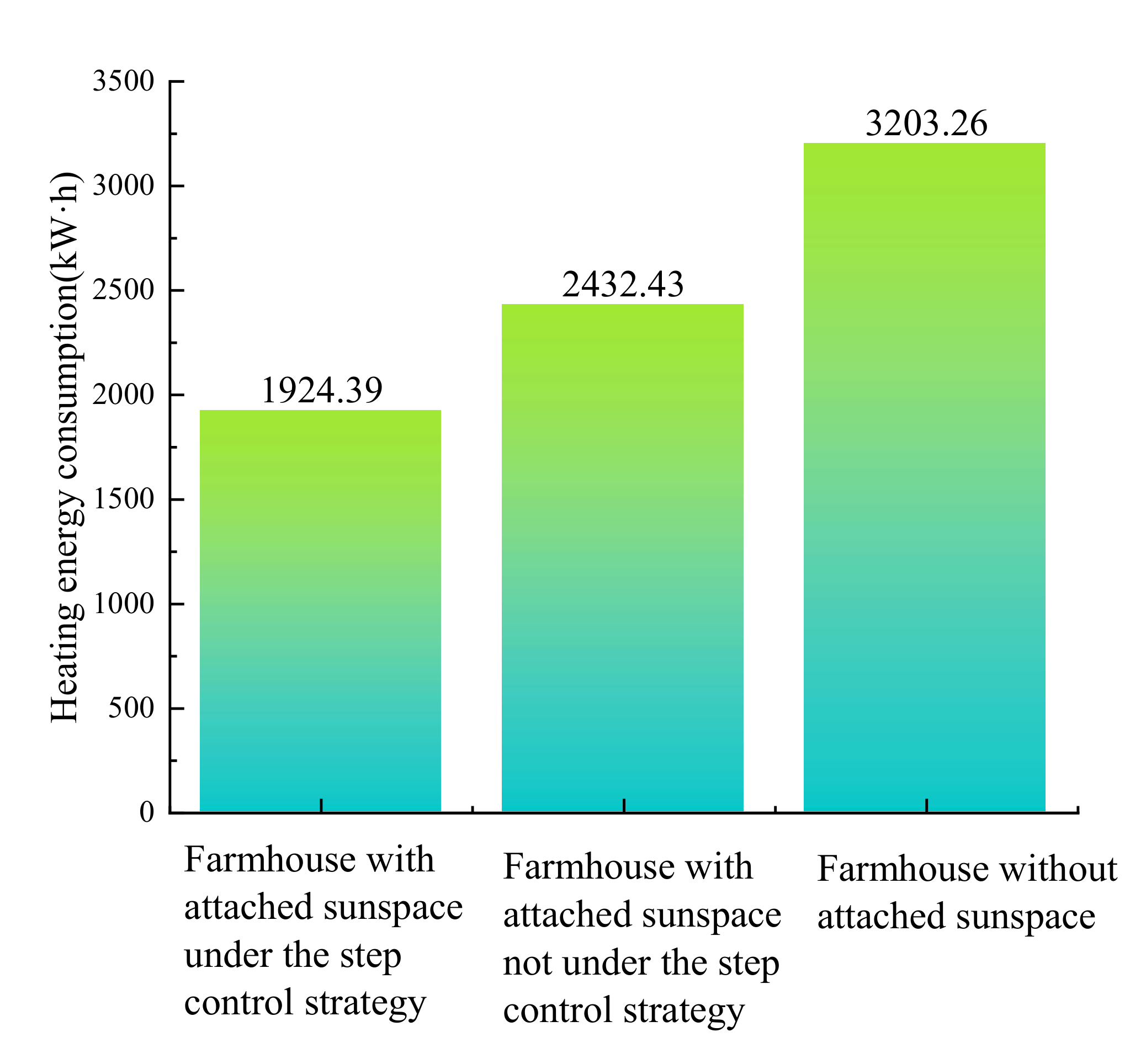
| Building Envelope | Heat Transfer Coefficient after Transformation W/(m2·K) | Heat Transfer Coefficient before Transformation W/(m2·K) |
|---|---|---|
| Roof | 0.301 | 1.56 |
| Ground | 0.35 | 0.5 |
| Exterior wall | 0.34 | 1.53 |
| Interior wall | 0.44 | 2.03 |
| Windows | 1.448 | 4.4 |
| Test Instrument | Rang | Accuracy |
|---|---|---|
| HOBO Portable Weather Station | 0~1280 W/m2 −40~+75 °C | ±10 W/m2 ±0.21 °C |
| HOBO Recorder of Temperature and Humidity | 20~70 °C 15–95% | ±0.21 °C ±3.5% |
| TR004 Temperature Recorder | −30~125 °C | ±0.5 °C |
| TNL-3RLTemperature and Heat Flow Monitoring System | −500~500 W/m2 | ±5% |
| Time | Maximum Temperature Difference (°C) | Position |
|---|---|---|
| 9:00 | 0.48 | S4 and N1 |
| 10:00 | 0.55 | S4 and N1 |
| 11:00 | 3.10 | S1 and N1 |
| 12:00 | 5.13 | S1 and N1 |
| 13:00 | 7.36 | S1 and N1 |
| 14:00 | 9.77 | S1 and N1 |
| 15:00 | 4.66 | S1 and N4 |
| 16:00 | 3.42 | S1 and N4 |
| 17:00 | 1.17 | S2 and N4 |
| 18:00 | 0.45 | S2 and N4 |
Publisher’s Note: MDPI stays neutral with regard to jurisdictional claims in published maps and institutional affiliations. |
© 2022 by the authors. Licensee MDPI, Basel, Switzerland. This article is an open access article distributed under the terms and conditions of the Creative Commons Attribution (CC BY) license (https://creativecommons.org/licenses/by/4.0/).
Share and Cite
Zhao, J.; Liu, D.; Lu, S. Research on the Indoor Thermal Environment of Attached Sunspace Passive Solar Heating System Based on Zero-State Response Control Strategy. Appl. Sci. 2022, 12, 855. https://doi.org/10.3390/app12020855
Zhao J, Liu D, Lu S. Research on the Indoor Thermal Environment of Attached Sunspace Passive Solar Heating System Based on Zero-State Response Control Strategy. Applied Sciences. 2022; 12(2):855. https://doi.org/10.3390/app12020855
Chicago/Turabian StyleZhao, Jing, Dehan Liu, and Shilei Lu. 2022. "Research on the Indoor Thermal Environment of Attached Sunspace Passive Solar Heating System Based on Zero-State Response Control Strategy" Applied Sciences 12, no. 2: 855. https://doi.org/10.3390/app12020855
APA StyleZhao, J., Liu, D., & Lu, S. (2022). Research on the Indoor Thermal Environment of Attached Sunspace Passive Solar Heating System Based on Zero-State Response Control Strategy. Applied Sciences, 12(2), 855. https://doi.org/10.3390/app12020855







